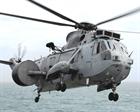D-day battle honours remembered by Culdrose Squadrons
This year marks the 70th anniversary of the Normandy Landings, centred on D-Day 06 June, the date of Allied landings in 1944. Two Fleet Air Arm Units from Royal Naval Air Station Culdrose proudly wear “NORMANDY” as one of their battle honours.
849 & 854 Naval Air Squadrons, both from today’s Airborne Surveillance and Control family who fly the Sea King Mk 7, have taken time to remember their illustrious forbearers.
The landings were part of the largest seaborne invasion ever launched heralded the end of the Second World War in Europe, involved British, Canadian, American and French forces, including hundreds of units from the Royal Navy. Around 150,000 Royal Marines and allied soldiers were transported by ships, landing craft and sea boats, with 23,400 arriving by air. The FAA, RAF and allied air forces provided air support with 11,000 aircraft.
Prior to and after D Day several Royal Navy FAA Grumman Avenger squadrons operated with Coastal Command from Hawkinge in Kent (854 and 855 sqns) and Perranporth in North Cornwall (849 and 850 sqns) carrying out what was described as “Channel Stop” operations, designed to prevent enemy shipping from entering the English Channel. They also escorted assault convoys and participated in many night attacks on E boats and German Minesweepers that could interfere with the “Overlord” landings.
Over a three month period from May 1944 both Sqns carried out long patrols in the Channel which in some cases lasted up to four or five hours at a time. Intensive anti-submarine searches were flown by day and anti-shipping patrols by night. They saw very little action because Channel Stop operations were so effective and successful, only one U-boat being attacked during June.
The Grumman Avenger torpedo, strike and reconnaissance aircraft was the successor to the iconic Swordfish Bi-plane which had been in service with the FAA since before the war. Capable of carrying up to four 500 pound bombs, depth charges, or mines it also had two forward and one rear facing browning machine guns.
854 NAS flying fromKentmade over 60 individual attacks on shipping and small highly manoeuvrable craft and in one instance brought down a V1 Flying bomb over the French coast. 849 NAS had a similar attack rate but it was their sister Sqn based in Cornwall, 850 NAS that got the prize, when they attacked and sunk a large German vessel off the coast of Guernsey.
After D-Day their role was complete and by August both 849 and 854 NAS along with many other FAA Sqns were heading to the Far East in the War against Japan as part of the British Pacific Fleet embarked on the Aircraft Carriers HMS Activity and HMS Victorious.
‘We are all immensely proud of our heritage and the hard-won battle honours with which our Squadrons have been honoured”, said Commander Andrew Rose, Sea King Force Commander at RNAS Culdrose.
“70 years on from D-Day we remember those who gave their all in defence of the nation and their memory lives on in today’s FAA Squadrons as we commemorate the rich history of Royal Naval aviation.”



